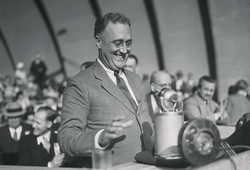Roosevelt Campaign
|
| updated |
Copy Link Code
|
 The four presidential campaigns of Franklin Roosevelt were tailored to meet the economic and social issues facing America at the time of each campaign. The following are overviews about each of Franklin Roosevelt's four campaigns:
The four presidential campaigns of Franklin Roosevelt were tailored to meet the economic and social issues facing America at the time of each campaign. The following are overviews about each of Franklin Roosevelt's four campaigns:
- The campaign and election of 1932: The Great Depression set the tone and the stage for Roosevelt's first campaign for the presidency, his most important. His message was simple: Roosevelt campaigned on a promise to use the resources and power of the federal government to create jobs for the unemployed, stall the present depression as well as prevent another from occurring, and to regulate industry as a way to curb unemployment and the imbalance of supply and demand. Roosevelt's campaign strategy was unprecedented.
Roosevelt's opponent, incumbent President Herbert Hoover was vulnerable due to the depression, but he still favored laissez-faire, an approach to economics wherein government interference in the business world is minimal. Roosevelt's campaign was just the opposite; instead of limiting government involvement in the economy, he intended to increase it by making the government an employer of jobless citizens, a move that got him elected multiple times.
The FDR campaign traveled to forty-one states, delivered radio addresses and kept his name and the Roosevelt campaign platform in the newspapers. FDR won the election by seven million popular votes and over four-hundred electoral votes. Franklin Roosevelt's election resulted in the most sweeping victory of the times.
- The campaign and election of 1936: As FDR's campaign began, the economy was still suffering from the depression and many people remained jobless. Roosevelt's campaign faced some resentment from his previous business supporters because of the Social Security Act and other legislation that favored the worker versus the business owner, but he continued to be supported by the voters. The Republicans capitalized on the resentment from business owners by nominating Governor Alfred Landon of Kansas, a moderate conservative who was also a businessman, but a poor campaigner. The Roosevelt campaign, as they had done in the previous election, courted the voter with the promise of continued economic recovery backed by the government.
Franklin Roosevelt's 1936 campaign became known as the "New Deal Coalition," which was comprised of ethnic, racial and religious groups from all over America. The coalition didn't disappoint the campaign; FDR won 61% of the popular vote and 99% of the electoral votes.
- The campaign and election of 1940: The Franklin Roosevelt campaign of 1940 centered on the escalating war in Europe, which Nazi Germany had just invaded. The popular opinion about the war favored isolationism and non-intervention, but Roosevelt thought otherwise. FDR's campaign also faced some rising opposition to his platform of more government, although the voters who were benefiting from it remained loyal to him.
The Republicans chose Wendell L. Willkie as FDR's Republican opponent, a lawyer who agreed with many of Roosevelt's New Deal approaches and his foreign policy. By the time Election Day came, the Roosevelt campaign had faced negative attacks by the Willkie supporters, namely relating to America's entry into the war, but Roosevelt promised not to get involved. FDR won the election with 55% of the popular vote and the electoral votes of thirty-eight states; it was a narrow victory in comparison to the two other Roosevelt elections.
- The campaign and election of 1944: Franklin Roosevelt's campaign and election of 1944 came in the midst of World War II, but he received the backing of his party for a fourth term. FDR's campaign selected Senator Harry Truman, who was backed by the big-boss party leaders, as his running mate.
The Republicans nominated Governor Thomas Dewey of New York, a moderate who promised to leave the New Deal programs in place while he worked to make them even better, a necessary move for any Roosevelt opponent. He portrayed FDR as a tired, sick old man whose lack of vigor had also stifled the economy. Franklin Roosevelt's campaign fought back; FDR encouraged his loyal voters not to "change horses in midstream," but to elect him again.
On Election Day, the Roosevelt campaign delivered him a fourth term by winning 54% of the popular vote and 432 electoral votes. The Republicans could not unseat FDR.
